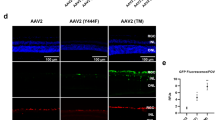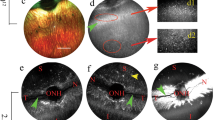Abstract
Neutralising antibodies (NAbs), caused by past adeno-associated virus (AAV) infection, represent a critical challenge for AAV-mediated gene therapy, with even low NAb titres capable of inhibiting gene transfer, however in protein-rich environments such as the vitreous it is expected that other constituents could also interact with the transduction process. Inhibition of AAV2/2, AAV2/5, AAV2/6 and AAV2/8 transduction by human vitreous humour (VH) obtained from 80 post-mortem eye cups was investigated in this report, with clinically relevant vitreous dilutions as low as 1:2. Unexpectedly, the highest prevalence of inhibition of transduction was observed against AAV2/6, with 66% of tested samples displaying neutralisation at a 1:2 VH dilution. Only two samples showed inhibition of AAV2/8, indicating this serotype is an attractive vector for use in non-vitrectomised eyes of unscreened individuals. Levels of anti-AAV NAbs observed in the VH were much lower than previously observed in serum of a similar Australian population. Among ten tested eye cup pairs, we observed only small variation in anti-AAV NAbs levels between the left and right eye cups. Interaction with 1:2 diluted VH had an augmentation effect on AAV2/8 transduction (p = 0.004), a phenomenon which was not due to albumin or transferrin and which, if developed, might benefit the use of AAV2/8 in clinical settings.
This is a preview of subscription content, access via your institution
Access options
Subscribe to this journal
Receive 12 print issues and online access
$259.00 per year
only $21.58 per issue
Buy this article
- Purchase on Springer Link
- Instant access to full article PDF
Prices may be subject to local taxes which are calculated during checkout






Similar content being viewed by others
References
Smalley E. First AAV gene therapy poised for landmark approval. Nat Biotechnol. 2017;35:998–9.
Colella P, Ronzitti G, Mingozzi F. Emerging issues in AAV-mediated in vivo gene therapy. Mol Ther Methods Clin Dev. 2018;8:87–104.
de Moraes G, Layton CJ. Therapeutic targeting of diabetic retinal neuropathy as a strategy in preventing diabetic retinopathy. Clin Exp Ophthalmol. 2016;44:838–52.
Rodrigues GA, Shalaev E, Karami TK, Cunningham J, Slater NK, Rivers HM. Pharmaceutical Development of AAV-Based Gene Therapy Products for the Eye. Pharm Res. 2019;36:29.
Dalkara D, Kolstad KD, Caporale N, Visel M, Klimczak RR, Schaffer DV, et al. Inner limiting membrane barriers to AAV-mediated retinal transduction from the vitreous. Mol Ther. 2009;17:2096–102.
Yin L, Greenberg K, Hunter JJ, Dalkara D, Kolstad KD, Masella BD, et al. Intravitreal injection of AAV2 transduces macaque inner retina. Investig Ophthalmol Vis Sci. 2011;52:2775–83.
Lau PE, Jenkins KS, Layton CJ. Current evidence for the prevention of endophthalmitis in anti-VEGF intravitreal injections. J Ophthalmol. 2018;2018:8567912.
Worst J, Los L. Comparative anatomy of the vitreous body in rhesus monkeys and man. Doc Ophthalmol. 1992;82:169–78.
Murthy KR, Goel R, Subbannayya Y, Jacob HK, Murthy PR, Manda SS, et al. Proteomic analysis of human vitreous humor. Clin Proteom. 2014;11:29.
Reich M, Dacheva I, Nobl M, Siwy J, Schanstra JP, Mullen W, et al. Proteomic analysis of vitreous humor in retinal vein occlusion. PloS one. 2016;11:e0158001.
Yamane K, Minamoto A, Yamashita H, Takamura H, Miyamoto-Myoken Y, Yoshizato K, et al. Proteome analysis of human vitreous proteins. Mol Cell Proteom. 2003;2:1177–87.
Angi M, Kalirai H, Coupland SE, Damato BE, Semeraro F, Romano MR. Proteomic analyses of the vitreous humour. Mediat Inflamm. 2012;2012:148039.
Bévalot F, Cartiser N, Bottinelli C, Fanton L, Guitton J. Vitreous humor analysis for the detection of xenobiotics in forensic toxicology: a review. Forensic Toxicol. 2016;34:12–40.
Scott JE. The chemical morphology of the vitreous. Eye 1992;6:553.
Le Goff M, Bishop P. Adult vitreous structure and postnatal changes. Eye 2008;22:1214.
Petrash JM. Aging and age-related diseases of the ocular lens and vitreous body. Investiga Ophthalmol Vis Sci. 2013;54:ORSF54–ORSF59.
Tan LE, Orilla W, Hughes PM, Tsai S, Burke JA, Wilson CG. Effects of vitreous liquefaction on the intravitreal distribution of sodium fluorescein, fluorescein dextran, and fluorescent microparticles. Investig Ophthalmol Vis Sci. 2011;52:1111–8.
Karhunen PJ, Brummer-Korvenkontio H, Leinikki P, Nyberg M. Stability of human immunodeficiency virus (HIV) antibodies in postmortem samples. J Forensic Sci. 1994;39:129–35.
Majumder PD, Sudharshan S, Biswas J. Laboratory support in the diagnosis of uveitis. Indian J Ophthalmol. 2013;61:269.
Mahendradas P, Ranganna SK, Shetty R, Balu R, Narayana KM, Babu RB, et al. Ocular manifestations associated with chikungunya. Ophthalmology. 2008;115:287–91.
Mahendradas P, Avadhani K, Shetty R. Chikungunya and the eye: a review. J Ophthalmic Inflamm Infect. 2013;3:35.
de Boer JH, Luyendijk L, Rothova A, Baarsma GS, de Jong PT, Bollemeijer J-G, et al. Detection of intraocular antibody production to herpesviruses in acute retinal necrosis syndrome. Am J Ophthalmol. 1994;117:201–10.
Van Gelder RN, Willig JL, Holland GN, Kaplan HJ. Herpes simplex virus type 2 as a cause of acute retinal necrosis syndrome in young patients. Ophthalmology. 2001;108:869–76.
Mathis A, Malecaze F, Bessieres M, Arne J, Seguela J, Bec P. Immunological analysis of the aqueous humour in candida endophthalmitis. II: Clinical study. Br J Ophthalmol. 1988;72:313–6.
Niu N, Zhang J, Sun Y, Wang S, Sun Y, Korteweg C, et al. Expression and distribution of immunoglobulin G and its receptors in an immune privileged site: the eye. Cell Mol Life Sci. 2011;68:2481–92.
Nogueira M, Siqueira R, Freitas N, Amorim J, Bonjardim C, Ferreira P, et al. Detection of herpesvirus DNA by the polymerase chain reaction (PCR) in vitreous samples from patients with necrotising retinitis. J Clin Pathol. 2001;54:103–6.
Andrzejewski S, Murali A, Ramlogan-Steel C, Edwards KP, Efron N, Steel JC et al. Adeno-associated virus neutralising antibodies in type 1 diabetes mellitus. Gene Ther. 2019;26:250–63.
Calcedo R, Vandenberghe LH, Gao G, Lin J, Wilson JM. Worldwide epidemiology of neutralizing antibodies to adeno-associated viruses. J Infect Dis. 2009;199:381–90.
Lee S, Kang IK, Kim JH, Jung BK, Park K, Chang H, et al. Relationship Between Neutralizing Antibodies Against Adeno-Associated Virus in the Vitreous and Serum: Effects on Retinal Gene Therapy. Transl Vis Sci Technol. 2019;8:14–14.
Harbison CE, Weichert WS, Gurda BL, Chiorini JA, Agbandje-McKenna M, Parrish CR. Examining the cross-reactivity and neutralization mechanisms of a panel of mAbs against adeno-associated virus serotypes 1 and 5. J Gen Virol. 2012;93:347–55.
Li C, Narkbunnam N, Samulski R, Asokan A, Hu G, Jacobson L, et al. Neutralizing antibodies against adeno-associated virus examined prospectively in pediatric patients with hemophilia. Gene Ther. 2012;19:288.
Ramlogan‐Steel CA, Murali A, Andrzejewski S, Dhungel B, Steel JC, Layton CJ. Gene therapy and the adeno‐associated virus in the treatment of genetic and acquired ophthalmic diseases in humans: Trials, future directions and safety considerations. Clin Exp Ophthalmol. 2019;47:521–36.
Naso MF, Tomkowicz B, Perry WL, Strohl WR. Adeno-associated virus (AAV) as a vector for gene therapy. Biodrugs. 2017;31:317–34.
Rapti K, Louis-Jeune V, Kohlbrenner E, Ishikawa K, Ladage D, Zolotukhin S, et al. Neutralizing antibodies against AAV serotypes 1, 2, 6, and 9 in sera of commonly used animal models. Mol Ther. 2012;20:73–83.
Pei X, He T, Hall NE, Gerber D, Samulski RJ, Li C. AAV8 virions hijack serum proteins to increase hepatocyte binding for transduction enhancement. Virology. 2018;518:95–102.
Brown DM, Kaiser PK, Michels M, Soubrane G, Heier JS, Kim RY, et al. Ranibizumab versus verteporfin for neovascular age-related macular degeneration. New Engl J Med. 2006;355:1432–44.
Regillo CD, Brown DM, Abraham P, Yue H, Ianchulev T, Schneider S, et al. Randomized, double-masked, sham-controlled trial of ranibizumab for neovascular age-related macular degeneration: PIER Study year 1. Am J Ophthalmol. 2008;145:239–48. e5.
Meyer CH, Krohne TU, Holz FG. Intraocular pharmacokinetics after a single intravitreal injection of 1.5 mg versus 3.0 mg of bevacizumab in humans. Retina. 2011;31:1877–84.
Mordenti J, Cuthbertson RA, Ferrara N, Thomsen K, Berleau L, Licko V, et al. Comparisons of the intraocular tissue distribution, pharmacokinetics, and safety of 125I-labeled full-length and Fab antibodies in rhesus monkeys following intravitreal administration. Toxicol Pathol. 1999;27:536–44.
Heiduschka P, Fietz H, Hofmeister S, Schultheiss S, Mack AF, Peters S, et al. Penetration of bevacizumab through the retina after intravitreal injection in the monkey. Investig Ophthalmol Vis Sci. 2007;48:2814–23.
MacLachlan TK, Lukason M, Collins M, Munger R, Isenberger E, Rogers C, et al. Preclinical safety evaluation of AAV2-sFLT01—a gene therapy for age-related macular degeneration. Mol Ther. 2011;19:326–34.
Halbert CL, Miller AD, Mcnamara S, Emerson J, Gibson RL, Ramsey B, et al. Prevalence of neutralizing antibodies against adeno-associated virus (AAV) types 2, 5, and 6 in cystic fibrosis and normal populations: Implications for gene therapy using AAV vectors. Human Gene Ther. 2006;17:440–7.
Denard J, Rouillon J, Leger T, Garcia C, Lambert MP, Griffith G, et al. AAV-8 and AAV-9 vectors cooperate with serum proteins differently than AAV-1 and AAV-6. Mol Ther Methods Clin Dev. 2018;10:291–302.
Karlsson A, Christenson K, Matlak M, Björstad Å, Brown KL, Telemo E, et al. Galectin-3 functions as an opsonin and enhances the macrophage clearance of apoptotic neutrophils. Glycobiology. 2008;19:16–20.
Díaz-Alvarez L, Ortega E. The many roles of galectin-3, a multifaceted molecule, in innate immune responses against pathogens. Mediat Inflamm. 2017;2017:9247574.
Denard J, Beley C, Kotin R, Lai-Kuen R, Blot S, Leh H, et al. Human galectin 3 binding protein interacts with recombinant adeno-associated virus type 6. J Virol. 2012;86:6620–31.
Obermann J, Priglinger CS, Merl-Pham J, Geerlof A, Priglinger S, Götz M, et al. Proteome-wide identification of glycosylation-dependent interactors of galectin-1 and galectin-3 on mesenchymal retinal pigment epithelial (RPE) cells. Mol Cell Proteom. 2017;16:1528–46.
Wang M, Sun J, Crosby A, Woodard K, Hirsch ML, Samulski RJ, et al. Direct interaction of human serum proteins with AAV virions to enhance AAV transduction: immediate impact on clinical applications. Gene Ther. 2017;24:49.
Zaiss AK, Cotter MJ, White LR, Clark SA, Wong NC, Holers VM, et al. Complement is an essential component of the immune response to adeno-associated virus vectors. J Virol. 2008;82:2727–40.
Hüser D, Khalid D, Lutter T, Hammer E-M, Weger S, Heßler M, et al. High prevalence of infectious adeno-associated virus (AAV) in human peripheral blood mononuclear cells indicative of T lymphocytes as sites of AAV persistence. J Virol. 2017;91:e02137–16.
Boutin S, Monteilhet V, Veron P, Leborgne C, Benveniste O, Montus MF, et al. Prevalence of serum IgG and neutralizing factors against adeno-associated virus (AAV) types 1, 2, 5, 6, 8, and 9 in the healthy population: implications for gene therapy using AAV vectors. Hum Gene Ther. 2010;21:704–12.
Cunha-Vaz J, De Abreu JF, Campos A. Early breakdown of the blood-retinal barrier in diabetes. Br J Ophthalmol. 1975;59:649–56.
Paul LM, Carlin ER, Jenkins MM, Tan AL, Barcellona CM, Nicholson CO, et al. Dengue virus antibodies enhance Zika virus infection. Clin Transl Immunol. 2016;5:e117.
Acknowledgements
We would like to thank the donors, the donors’ families and the team from Queensland Eye Bank for their generosity and involvement in donating, collecting and providing samples for research. We also thank Layton Vision Foundation for the technical support, lab space and equipment to perform and analyse presented experiments. Brett Stringer is supported by a Fellowship from the Layton Vision Foundation. Sławomir Andrzejewski was supported by a Scholarship from the Gallipoli Medical Research Foundation.
Author information
Authors and Affiliations
Corresponding author
Ethics declarations
Conflict of interest
The authors declare that they have no conflict of interest.
Additional information
Publisher’s note Springer Nature remains neutral with regard to jurisdictional claims in published maps and institutional affiliations.
Rights and permissions
About this article
Cite this article
Andrzejewski, S., Moyle, P.M., Stringer, B.W. et al. Neutralisation of adeno-associated virus transduction by human vitreous humour. Gene Ther 28, 242–255 (2021). https://doi.org/10.1038/s41434-020-0162-8
Received:
Revised:
Accepted:
Published:
Issue Date:
DOI: https://doi.org/10.1038/s41434-020-0162-8



